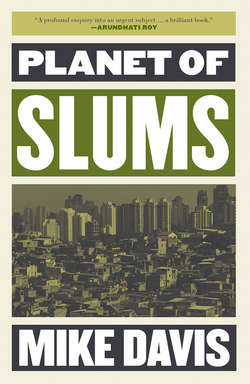Читать книгу Planet of Slums - Mike Davis - Страница 12
На сайте Литреса книга снята с продажи.
A Global Slum Census
ОглавлениеThe authors of The Challenge of Slums discard these Victorian calumnies but otherwise preserve the classical definition of a slum, characterized by overcrowding, poor or informal housing, inadequate access to safe water and sanitation, and insecurity of tenure. This operational definition, officially adopted at a UN meeting in Nairobi in October 2002, is “restricted to the physical and legal characteristics of the settlement,” and eschews the more difficult-to-measure “social dimensions,” although it equates under most circumstances to economic and social marginality.11 Encompassing peri-urban shantytowns as well as archetypal inner-city tenements, this multidimensional approach is in practice a very conservative gauge of what qualifies as a slum; many readers will be surprised by the UN’s counter-experiential finding that only 19.6 percent of urban Mexicans live in slums (it is generally conceded by local experts that almost two-thirds of Mexicans live in colonias populares or older tenements). Even using this restrictive definition, the UN researchers estimate that there were at least 921 million slum-dwellers in 2001 and more than one billion in 2005: nearly equal to the population of the world when the young Engels first ventured onto the mean streets of St. Giles and Old Town Manchester in 1844.12
Indeed, neoliberal capitalism since 1970 has multiplied Dickens’s notorious slum of Tom-all-Alone’s in Bleak House by exponential powers. Residents of slums, while only 6 percent of the city population of the developed countries, constitute a staggering 78.2 percent of urbanites in the least developed countries; this equals fully a third of the global urban population.
According to UN-Habitat, the world’s highest percentages of slum-dwellers are in Ethiopia (an astonishing 99.4 percent of the urban population), Chad (also 99.4 percent), Afghanistan (98.5 percent), and Nepal (92 percent). Bombay, with 10 to 12 million squatters and tenement-dwellers, is the global capital of slum-dwelling, followed by Mexico City and Dhaka (9 to 10 million each), and then Lagos, Cairo, Karachi, Kinshasa-Brazzaville, São Paulo, Shanghai, and Delhi (6 to 8 million each).13
The fastest-growing slums are in the Russian Federation (especially ex-“socialist company towns” dependent on a single, now-closed industry) and the former Soviet republics, where urban dereliction has been bred at the same stomach-churning velocity as economic inequality and civic disinvestment. In 1993 the UN Urban Indicators Programme reported poverty rates of 80 percent or higher in both Baku (Azerbaijan) and Yerevan (Armenia).15 Likewise, the concrete-and-steel Soviet-era urban core of Ulaanbaatar is now surrounded by a sea of 500,000 or more impoverished, former pastoralists living in tents called gers, few of whom manage to eat more than once a day.16
Figure 6.14 Largest Slum Populations by Country
The poorest urban populations, however, are probably found in Luanda, Maputo, Kinshasa, and Cochabamba (Bolivia), where two-thirds or more of residents earn less than the cost of their minimum required daily nutrition.17 In Luanda, where one quarter of the households have per capita consumptions of less than 75 cents per day, child mortality (under five) was a horrifying 320 per thousand in 1993 – the highest in the world.18
Not all urban poor, to be sure, live in slums, nor are all slum-dwellers poor; indeed, The Challenge of Slums underlines that in some cities the majority of the poor actually live outside the slums stricto sensu.19 Although the two categories obviously overlap in their majority, the number of urban poor is considerably greater: at least one-half of the world’s urban population as defined by relative national poverty thresholds.20 Approximately one quarter of urbanites (as surveyed in 1988), moreover, live in barely imaginable “absolute” poverty – somehow surviving on one dollar or less per day.21 If UN data are accurate, the household per-capita income differential between a rich city like Seattle and a very poor city like Ibadan is as great as 739-to-1 – an incredible inequality.22
Accurate statistics are in fact difficult to come by, because poor and slum populations are often deliberately and sometimes massively under-counted by officials. In the late 1980s, for example, Bangkok had an official poverty rate of only 5 percent, yet surveys found nearly a quarter of the population (1.16 million) living in 1000 slums and squatter camps.23 Likewise the government of Mexico claimed in the 1990s that only one in ten urbanites was truly poor, despite uncontested UN data that showed nearly 40 percent living on less than $2 per day.24 Indonesian and Malaysian statistics are also notorious for disguising urban poverty. The official figure for Jakarta, where most researchers estimate that one quarter of the population are poor kampung dwellers, is simply absurd: less than 5 percent.25 In Malaysia, geographer Jonathan Rigg complains that the official poverty line “fails to take account of the higher cost of urban living” and deliberately undercounts the Chinese poor.26 Urban sociologist Erhard Berner, meanwhile, believes that poverty estimates for Manila are purposefully obfuscated, and that at least one-eighth of the slum population is uncounted.27
